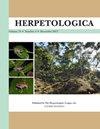Low-Intensity Agriculture Shapes Amphibian and Reptile Communities: Insights from a 10-Year Monitoring Study
IF 1.1
3区 生物学
Q2 ZOOLOGY
引用次数: 0
Abstract
Abstract: Intensification and expansion of agriculture is one of the most pressing concerns for biodiversity conservation. Amphibian and reptile communities can be particularly sensitive to land-use change; therefore, understanding how land use and agricultural practices influence these communities in areas under increasing agricultural pressure is prudent. Over 10 yr, we sampled amphibian and reptile communities in and around 18 man-made ponds set within an agricultural/forest matrix on a military installation in western Tennessee. Ponds had either cattle access or were cattle restricted and had different surrounding land uses (forest, pasture, row crops, and industrial development). We used Akaike information criterion, corrected (AICc), model selection and nonmetric multidimensional scaling (NMDS) to assess how land-cover and pond characteristics influence amphibian and reptile richness, diversity, and community structure. Our results indicate that, despite reduced water quality, amphibian diversity was higher in ponds with cattle access, though this is likely influenced by surrounding forest, pasture, and row-crop cover. Pond permanence was important in shaping amphibian community structure and is a key factor in determining amphibian richness. We did not find any link between land cover and cattle access on reptile richness or diversity, though reptile community structure was influenced by cattle access, pasture, and row-crop cover.低强度农业塑造两栖动物和爬行动物群落:来自10年监测研究的见解
摘要:农业集约化和规模化是生物多样性保护最紧迫的问题之一。两栖动物和爬行动物群落可能对土地利用变化特别敏感;因此,了解在农业压力日益增加的地区,土地利用和农业做法如何影响这些社区是明智的。在过去的10年里,我们在田纳西州西部的一个军事设施的农业/森林基质中对18个人造池塘及其周围的两栖动物和爬行动物群落进行了采样。池塘要么有牛进入,要么限制牛进入,并有不同的周围土地用途(森林、牧场、行作物和工业发展)。我们利用Akaike信息标准、校正(AICc)、模型选择和非度量多维尺度(NMDS)来评估土地覆盖和池塘特征对两栖和爬行动物丰富度、多样性和群落结构的影响。我们的研究结果表明,尽管水质下降,但在有牛进入的池塘中,两栖动物的多样性更高,尽管这可能受到周围森林、牧场和行作物覆盖的影响。池塘持久性对两栖动物群落结构的形成具有重要意义,是决定两栖动物丰富度的关键因素。我们没有发现土地覆盖和牛的取取地对爬行动物丰富度和多样性的影响,但爬行动物的群落结构受到牛的取取地、牧场和行作物覆盖的影响。
本文章由计算机程序翻译,如有差异,请以英文原文为准。
求助全文
约1分钟内获得全文
求助全文
来源期刊

Herpetologica
生物-动物学
CiteScore
4.60
自引率
0.00%
发文量
27
审稿时长
>12 weeks
期刊介绍:
Established in 1936, Herpetologica is a quarterly peer-reviewed journal serving herpetologists, biologists, ecologists, conservationists, researchers and the scientific community. The journal contains original research papers and essays about the biology of reptiles and amphibians, and covers many relevant topics including: behavior, conservation, ecology, genetics, morphology, physiology and taxonomy.
 求助内容:
求助内容: 应助结果提醒方式:
应助结果提醒方式:


